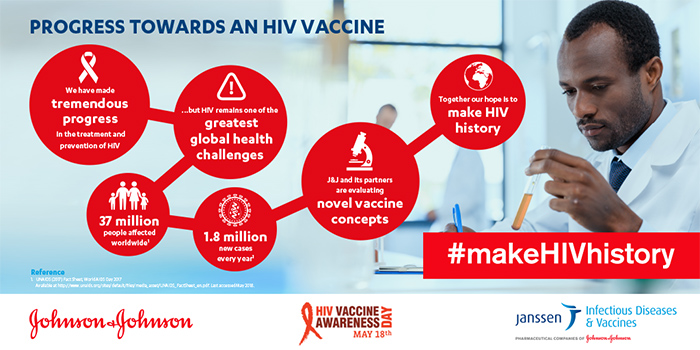Twenty Years of Progress in Search for an HIV Vaccine
The world’s inaugural HIV Vaccine Awareness Day (HVAD) was held 20 years ago. HVAD was created in 1998 to commemorate U.S. President Bill Clinton’s declaration that the world needed – and was capable of finding – an HIV vaccine to help stop the pandemic. He said, “It is no longer a question of whether we can develop an AIDS vaccine, it is simply a question of when. And it cannot come a day too soon.”
Many compared Clinton’s statement to President Kennedy’s famous 1961 "Moon Shot” speech.
So, where are we in the historic medical mission to find an HIV vaccine?
Well, the world doesn’t yet have a proven vaccine for HIV, and there have been some hurdles to overcome in clinical research over the years. It hasn’t been easy. But today, there is a new optimism in the field of HIV vaccine research.
An important milestone was reached in 2009, when results from the RV144 trial in Thailand demonstrated that a candidate vaccine could elicit a degree of protection against HIV acquisition. The vaccine lowered the rate of infection by 31 percent among study volunteers. Although relatively modest, this was a significant finding and important lessons were learned from this trial, that have since helped to inform the selection of novel HIV vaccine candidates.
Today, for the first time ever, two clinical studies are running in parallel in sub-Saharan Africa, both testing the efficacy of novel HIV vaccine regimens.

The first, called HVTN 702 (also known as Uhambo), is being conducted by the HIV Vaccine Trials Network (HVTN) and is sponsored by the National Institute of Allergy and Infectious Diseases (NIAID). It launched in late 2016 in South Africa with major co-funding from NIAID and the Bill & Melinda Gates Foundation. HVTN 702 is evaluating a newer version of the vaccine regimen that was tested in the RV144 Thai trial, with the goal of building and improving on that first signal of success. This new regimen now targets a subtype of HIV, known as Clade C, which is prevalent in southern Africa.
The second, called HVTN 705/HPX2008 (also known as Imbokodo) is sponsored by Janssen Vaccines, and is supported by a new global public-private partnership led by Janssen, the Bill & Melinda Gates Foundation, NIAID and HVTN.*
HVTN 705/HPX2008 launched just a year after HVTN 702 – in November 2017 – and is evaluating the efficacy and safety of an investigational “mosaic”-based preventive vaccine regimen for HIV. This vaccine regimen is based on mosaic immunogens — vaccine components designed to induce immune responses against a wide variety of viral strains responsible for HIV infections worldwide. The ultimate goal is to achieve a “global vaccine” for HIV that could be deployed around the world.
Looking beyond important vaccine studies like HVTN 705/HPX2008 and HVTN 702, it’s important to acknowledge the diverse range of HIV prevention research programs going on in the world today. There are many promising scientific avenues being explored – including broadly neutralizing antibodies (bNAbs), newer and longer-acting forms of pre-exposure prophylaxis (PrEP), and microbicides such as the dapivirine vaginal ring being developed by the International Partnership for Microbicides with Janssen’s support.
It’s clear that some of the world’s best scientists and most engaged health advocates are involved in advancing HIV prevention. I think Bill Clinton was right: It’s a question of when, not if, the world will find an effective HIV vaccine – and it can’t come a day too soon!
* Janssen is proud to be working with our scientific and protocol implementation partner, the HIV Vaccine Trials Network (HVTN). Together we are observing Good Participatory Practice (GPP) Guidelines, which were developed by AVAC and UNAIDS. HVTN and the South African Medical Research Council are supporting Imbokodo community engagement at the trial sites. Additional organizations providing support to Imbokodo include the U.S. Military HIV Research Program at the Walter Reed Army Institute of Research, U.S. Army Medical Material Development Activity, and the Ragon Institute.

